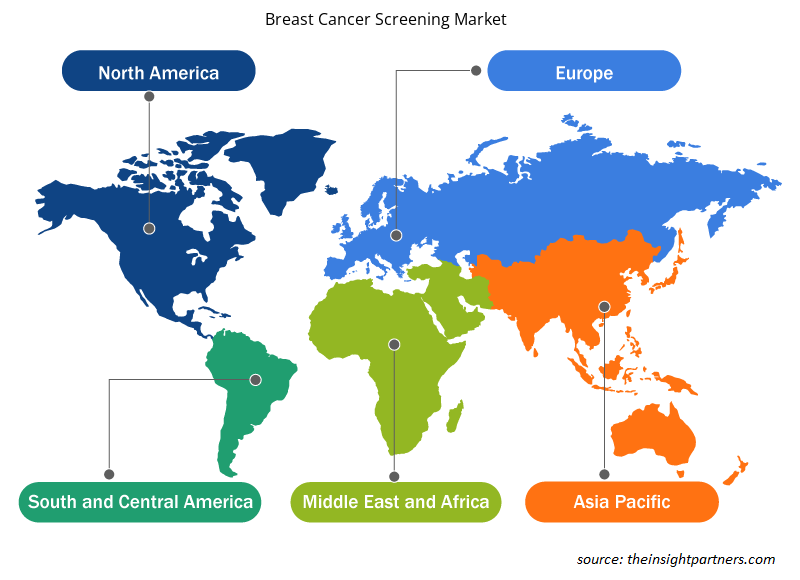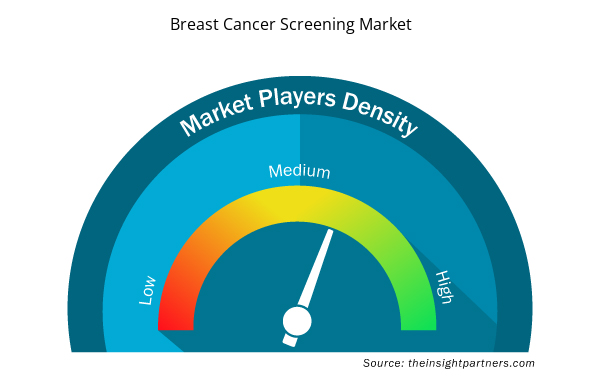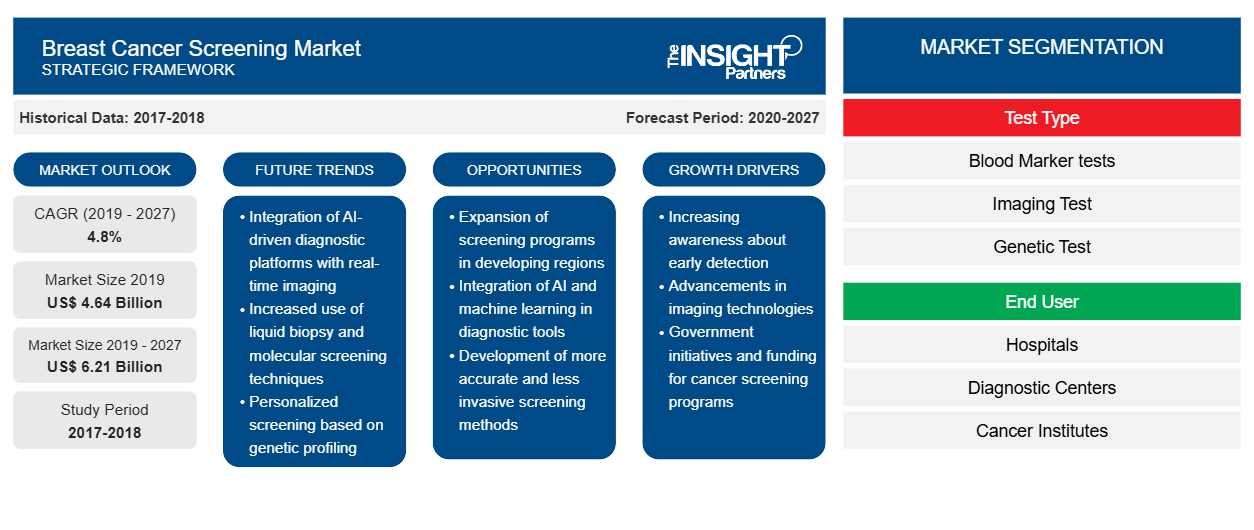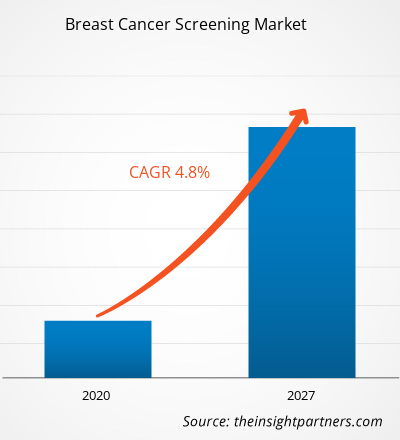[Rapport de recherche] Le marché du dépistage du cancer du sein devrait atteindre 6 209,25 millions USD d'ici 2027, contre 4 638,63 millions USD en 2019 ; il devrait croître à un TCAC de 4,8 % de 2020 à 2027.CAGR of 4.8% from 2020 to 2027.
Le cancer du sein est le type de cancer le plus courant et le plus répandu chez les femmes. Il se développe dans les tissus mammaires, généralement dans les canaux (tubes qui transportent le lait jusqu'au mamelon) et les lobules (glandes qui produisent le lait). Il peut également se développer dans le tissu adipeux ou le tissu conjonctif fibreux des seins. Un diagnostic précoce du cancer du sein est important car il peut empêcher la maladie de devenir critique et garantir un traitement curable et efficace. Les méthodes de dépistage pour le diagnostic du cancer du sein comprennent la mammographie, l'imagerie par résonance magnétique (IRM), l'échographie et d'autres. L'objectif principal du dépistage est de détecter la maladie à son stade le plus précoce et le plus traitable. Les procédures de dépistage identifient les premiers signes de cancer, avant même que les symptômes ne commencent à apparaître.lobules (glands that make milk). It can also occur in the fatty tissue or fibrous connective tissue within breasts. Early diagnosis of breast cancer is important as it may prevent the condition from becoming critical and ensure a successful curable treatment. The screening methods for the diagnosis of breast cancer include mammography, magnetic resonance imaging (MRI), ultrasound, and others. The foremost goal of screening is to detect disease at its earliest and most treatable stage. The screening procedures identify the early signs of cancer, even before the symptoms begin to show.
Personnalisez ce rapport en fonction de vos besoins
Vous bénéficierez d'une personnalisation gratuite de n'importe quel rapport, y compris de certaines parties de ce rapport, d'une analyse au niveau des pays, d'un pack de données Excel, ainsi que de superbes offres et réductions pour les start-ups et les universités.
- Obtenez les principales tendances clés du marché de ce rapport.Cet échantillon GRATUIT comprendra une analyse de données, allant des tendances du marché aux estimations et prévisions.
Informations sur le marché
La prévalence du cancer du sein augmente à l'échelle mondiale
Le cancer du sein est l'une des principales causes de décès dans le monde et affecte profondément la qualité de vie. Ainsi, il constitue un fardeau pour la société s'il n'est pas diagnostiqué et traité à temps. Selon les estimations de l'American Cancer Society, le cancer du sein est le type de cancer le plus courant aux États-Unis, car il a causé une morbidité chez environ 234 087 personnes et entraîné 41 904 décès en 2018. En outre, environ 276 480 nouveaux cas sont attendus dans le pays en 2020. Selon le rapport Globocan 2019, en Allemagne, le nombre total de cas de cancer du sein en 2018 était de 71 888, et la maladie a entraîné environ 19 376 décès cette année-là. En outre, selon le rapport Globocan, en 2018, il y a eu environ 367 900 nouveaux cas de cancer du sein et 97 972 décès dus à ce cancer en Chine. En Inde, les ONG, les agences gouvernementales et les organisations caritatives mettent l’accent sur la sensibilisation au cancer du sein auprès de la population afin de promouvoir la détection précoce, de fournir un module de traitement complet et d’étendre le soutien à la gestion du cancer du sein. De telles initiatives sont le résultat de la prévalence croissante de ce type de cancer dans le pays. Selon l’estimation du rapport Globocan, en 2018, l’Inde a signalé environ 162 468 nouveaux cas de cancer du sein et 87 090 décès dus à ce cancer. Cette prévalence croissante du cancer du sein dans différentes régions du monde augmente la demande mondiale d’appareils de dépistage pour ce cancer.
Informations sur le marché basées sur les types de tests
Le marché du dépistage du cancer du sein , par type de produit, est segmenté en tests de marqueurs sanguins, tests d'imagerie, tests génétiques, tests d'immunohistochimie. Le segment des tests d'imagerie détenait la plus grande part du marché en 2019, et il devrait également enregistrer le TCAC le plus élevé du marché au cours de la période de prévision.
Informations basées sur l'utilisateur final
Sur la base de l'utilisateur final, le marché du dépistage du cancer du sein a été segmenté en hôpitaux, centres de diagnostic, instituts de cancérologie et laboratoires de recherche. Le segment des hôpitaux détenait la plus grande part du marché en 2019, tandis que le segment des centres de diagnostic devrait enregistrer le TCAC le plus élevé du marché au cours de la période de prévision.
Les lancements et les approbations de produits sont une stratégie couramment adoptée par les entreprises du marché du dépistage du cancer du sein pour étendre leur présence dans le monde entier et répondre à la demande croissante en élargissant leur portefeuille de produits. Elles adoptent également la stratégie d'expansion pour élargir leur base de clients à travers le monde, ce qui leur permet également de maintenir leur nom de marque à l'échelle mondiale. Par exemple, en juin 2017, Siemens Healthineers a reçu l'approbation de la Food and Drug Administration (FDA) pour le produit syngo.via VB20 qui est susceptible d'être utilisé pour l'imagerie moléculaire (MI) de Siemens Healthineers - une nouvelle version du logiciel de visualisation intelligente établi par la société pour l'imagerie multimodale.
Aperçu régional du marché du dépistage du cancer du sein
Les tendances et facteurs régionaux influençant le marché du dépistage du cancer du sein tout au long de la période de prévision ont été expliqués en détail par les analystes d’Insight Partners. Cette section traite également des segments et de la géographie du marché du dépistage du cancer du sein en Amérique du Nord, en Europe, en Asie-Pacifique, au Moyen-Orient et en Afrique, ainsi qu’en Amérique du Sud et en Amérique centrale.

- Obtenez les données régionales spécifiques au marché du dépistage du cancer du sein
Portée du rapport sur le marché du dépistage du cancer du sein
| Attribut de rapport | Détails |
|---|---|
| Taille du marché en 2019 | 4,64 milliards de dollars américains |
| Taille du marché d'ici 2027 | 6,21 milliards de dollars américains |
| Taux de croissance annuel composé mondial (2019-2027) | 4,8% |
| Données historiques | 2017-2018 |
| Période de prévision | 2020-2027 |
| Segments couverts | Par type de test
|
| Régions et pays couverts | Amérique du Nord
|
| Leaders du marché et profils d'entreprises clés |
|
Densité des acteurs du marché : comprendre son impact sur la dynamique des entreprises
Le marché du dépistage du cancer du sein connaît une croissance rapide, tirée par la demande croissante des utilisateurs finaux en raison de facteurs tels que l'évolution des préférences des consommateurs, les avancées technologiques et une plus grande sensibilisation aux avantages du produit. À mesure que la demande augmente, les entreprises élargissent leurs offres, innovent pour répondre aux besoins des consommateurs et capitalisent sur les tendances émergentes, ce qui alimente davantage la croissance du marché.
La densité des acteurs du marché fait référence à la répartition des entreprises ou des sociétés opérant sur un marché ou un secteur particulier. Elle indique le nombre de concurrents (acteurs du marché) présents sur un marché donné par rapport à sa taille ou à sa valeur marchande totale.
Les principales entreprises opérant sur le marché du dépistage du cancer du sein sont :
- Royal Philips NV.
- HOLOGIC, INC.
- BD
- MYRIAD GÉNÉTIQUE, INC.
- SIEMENS HEALTHCARE GMBH
Avis de non-responsabilité : les sociétés répertoriées ci-dessus ne sont pas classées dans un ordre particulier.

- Obtenez un aperçu des principaux acteurs du marché du dépistage du cancer du sein
Marché du dépistage du cancer du sein – Par type de produit
- Test de marqueur sanguin
- Test d'imagerie
- Test génétique
- Test d'immunohistochimie
Marché du dépistage du cancer du sein – Par application
- Centres de diagnostic
- Hôpitaux
- Laboratoires de recherche
- Instituts de cancérologie
Dépistage du cancer du sein – par zone géographique
- Amérique du Nord
- NOUS
- Canada
- Mexique
- Europe
- France
- Allemagne
- Italie
- ROYAUME-UNI
- Espagne
- Reste de l'Europe
- Asie-Pacifique
- Chine
- Inde
- Corée du Sud
- Japon
- Australie
- Reste de l'Asie-Pacifique
- Moyen-Orient et Afrique
- Afrique du Sud
- Arabie Saoudite
- Émirats arabes unis
- Reste du Moyen-Orient et de l'Afrique
- Amérique du Sud
- Brésil
- Argentine
- Reste de l'Amérique du Sud
Profils d'entreprise
- Compagnie Générale d'Électricité
- Siemens Healthineers SA
- Société des Sciences Exactes
- Royal Philips NV
- Hologic, Inc.
- BD
- Myriad Genetics, Inc.
- Société Oncocyte
- Danaher
- Systèmes médicaux POC
- Analyse historique (2 ans), année de base, prévision (7 ans) avec TCAC
- Analyse PEST et SWO
- Taille du marché Valeur / Volume - Mondial, Régional, Pays
- Industrie et paysage concurrentiel
- Ensemble de données Excel


- Small Internal Combustion Engine Market
- Cell Line Development Market
- EMC Testing Market
- Pipe Relining Market
- Wind Turbine Composites Market
- Europe Industrial Chillers Market
- Electronic Data Interchange Market
- Maritime Analytics Market
- Data Annotation Tools Market
- Nuclear Waste Management System Market

Report Coverage
Revenue forecast, Company Analysis, Industry landscape, Growth factors, and Trends

Segment Covered
This text is related
to segments covered.

Regional Scope
North America, Europe, Asia Pacific, Middle East & Africa, South & Central America

Country Scope
This text is related
to country scope.
Questions fréquemment posées
The North American region holds the largest market for the breast cancer screening. The United States held the largest market for breast cancer screening mean market and is expected to grow due to factors such as increasing number of rising in prevalence of breast cancer, growing developments for screening and imaging process by the companies and others.
The diagnosis of breast cancer is done through breast cancer screening methods such as mammography, magnetic resonance imaging (MRI), ultrasound, and others. Screening examinations are tests performed for early diagnosis of the disease. The foremost goal of screening is to detect disease at its earliest and most treatable stage.
The growth of the market is attributed to some key driving factors such as increasing number of breast cancer cases, growing geriatric population and rising adoption of technology for screening purpose. However, high cost of screening method and bassinet on global business due to coronavirus pandemic are expected to restraint the growth of the market during the forecast years.
Trends and growth analysis reports related to Life Sciences : READ MORE..
The List of Companies - Breast Cancer Screening Market
- Koninklijke Philips N.V..
- HOLOGIC, INC.
- BD
- MYRIAD GENETICS, INC.
- SIEMENS HEALTHCARE GMBH
- Exact Sciences Corporation
- ONCOCYTE CORPORATION
- POC MEDICAL SYSTEMS
- Danaher
- GENERAL ELECTRIC
The Insight Partners performs research in 4 major stages: Data Collection & Secondary Research, Primary Research, Data Analysis and Data Triangulation & Final Review.
- Data Collection and Secondary Research:
As a market research and consulting firm operating from a decade, we have published and advised several client across the globe. First step for any study will start with an assessment of currently available data and insights from existing reports. Further, historical and current market information is collected from Investor Presentations, Annual Reports, SEC Filings, etc., and other information related to company’s performance and market positioning are gathered from Paid Databases (Factiva, Hoovers, and Reuters) and various other publications available in public domain.
Several associations trade associates, technical forums, institutes, societies and organization are accessed to gain technical as well as market related insights through their publications such as research papers, blogs and press releases related to the studies are referred to get cues about the market. Further, white papers, journals, magazines, and other news articles published in last 3 years are scrutinized and analyzed to understand the current market trends.
- Primary Research:
The primarily interview analysis comprise of data obtained from industry participants interview and answers to survey questions gathered by in-house primary team.
For primary research, interviews are conducted with industry experts/CEOs/Marketing Managers/VPs/Subject Matter Experts from both demand and supply side to get a 360-degree view of the market. The primary team conducts several interviews based on the complexity of the markets to understand the various market trends and dynamics which makes research more credible and precise.
A typical research interview fulfils the following functions:
- Provides first-hand information on the market size, market trends, growth trends, competitive landscape, and outlook
- Validates and strengthens in-house secondary research findings
- Develops the analysis team’s expertise and market understanding
Primary research involves email interactions and telephone interviews for each market, category, segment, and sub-segment across geographies. The participants who typically take part in such a process include, but are not limited to:
- Industry participants: VPs, business development managers, market intelligence managers and national sales managers
- Outside experts: Valuation experts, research analysts and key opinion leaders specializing in the electronics and semiconductor industry.
Below is the breakup of our primary respondents by company, designation, and region:

Once we receive the confirmation from primary research sources or primary respondents, we finalize the base year market estimation and forecast the data as per the macroeconomic and microeconomic factors assessed during data collection.
- Data Analysis:
Once data is validated through both secondary as well as primary respondents, we finalize the market estimations by hypothesis formulation and factor analysis at regional and country level.
- Macro-Economic Factor Analysis:
We analyse macroeconomic indicators such the gross domestic product (GDP), increase in the demand for goods and services across industries, technological advancement, regional economic growth, governmental policies, the influence of COVID-19, PEST analysis, and other aspects. This analysis aids in setting benchmarks for various nations/regions and approximating market splits. Additionally, the general trend of the aforementioned components aid in determining the market's development possibilities.
- Country Level Data:
Various factors that are especially aligned to the country are taken into account to determine the market size for a certain area and country, including the presence of vendors, such as headquarters and offices, the country's GDP, demand patterns, and industry growth. To comprehend the market dynamics for the nation, a number of growth variables, inhibitors, application areas, and current market trends are researched. The aforementioned elements aid in determining the country's overall market's growth potential.
- Company Profile:
The “Table of Contents” is formulated by listing and analyzing more than 25 - 30 companies operating in the market ecosystem across geographies. However, we profile only 10 companies as a standard practice in our syndicate reports. These 10 companies comprise leading, emerging, and regional players. Nonetheless, our analysis is not restricted to the 10 listed companies, we also analyze other companies present in the market to develop a holistic view and understand the prevailing trends. The “Company Profiles” section in the report covers key facts, business description, products & services, financial information, SWOT analysis, and key developments. The financial information presented is extracted from the annual reports and official documents of the publicly listed companies. Upon collecting the information for the sections of respective companies, we verify them via various primary sources and then compile the data in respective company profiles. The company level information helps us in deriving the base number as well as in forecasting the market size.
- Developing Base Number:
Aggregation of sales statistics (2020-2022) and macro-economic factor, and other secondary and primary research insights are utilized to arrive at base number and related market shares for 2022. The data gaps are identified in this step and relevant market data is analyzed, collected from paid primary interviews or databases. On finalizing the base year market size, forecasts are developed on the basis of macro-economic, industry and market growth factors and company level analysis.
- Data Triangulation and Final Review:
The market findings and base year market size calculations are validated from supply as well as demand side. Demand side validations are based on macro-economic factor analysis and benchmarks for respective regions and countries. In case of supply side validations, revenues of major companies are estimated (in case not available) based on industry benchmark, approximate number of employees, product portfolio, and primary interviews revenues are gathered. Further revenue from target product/service segment is assessed to avoid overshooting of market statistics. In case of heavy deviations between supply and demand side values, all thes steps are repeated to achieve synchronization.
We follow an iterative model, wherein we share our research findings with Subject Matter Experts (SME’s) and Key Opinion Leaders (KOLs) until consensus view of the market is not formulated – this model negates any drastic deviation in the opinions of experts. Only validated and universally acceptable research findings are quoted in our reports.
We have important check points that we use to validate our research findings – which we call – data triangulation, where we validate the information, we generate from secondary sources with primary interviews and then we re-validate with our internal data bases and Subject matter experts. This comprehensive model enables us to deliver high quality, reliable data in shortest possible time.


 Obtenez un échantillon gratuit pour ce rapport
Obtenez un échantillon gratuit pour ce rapport